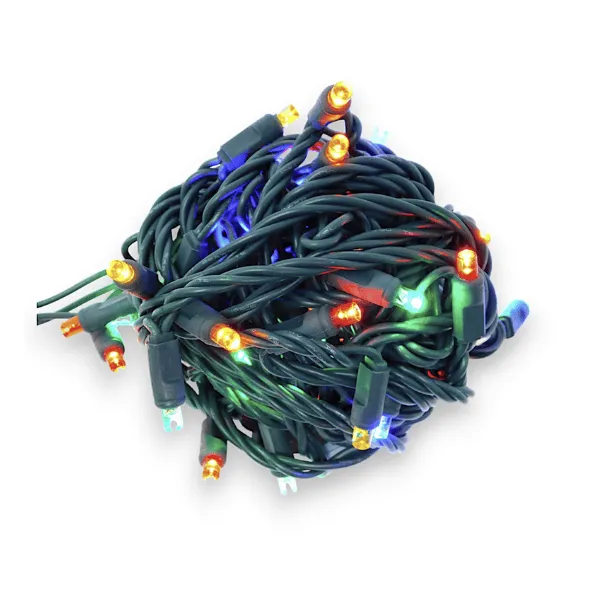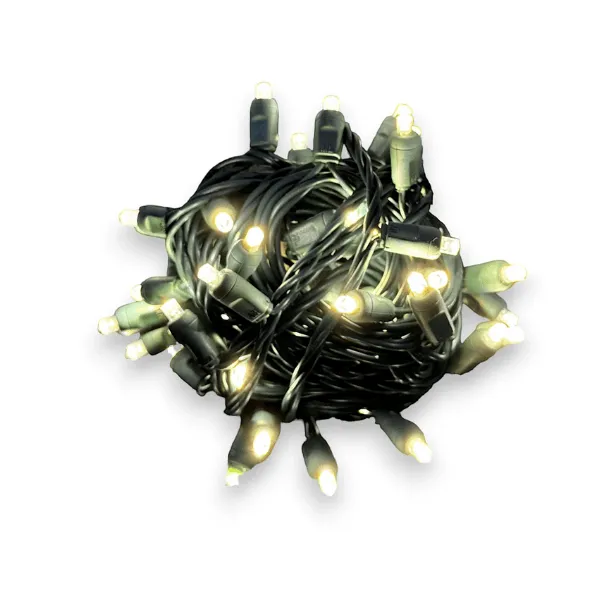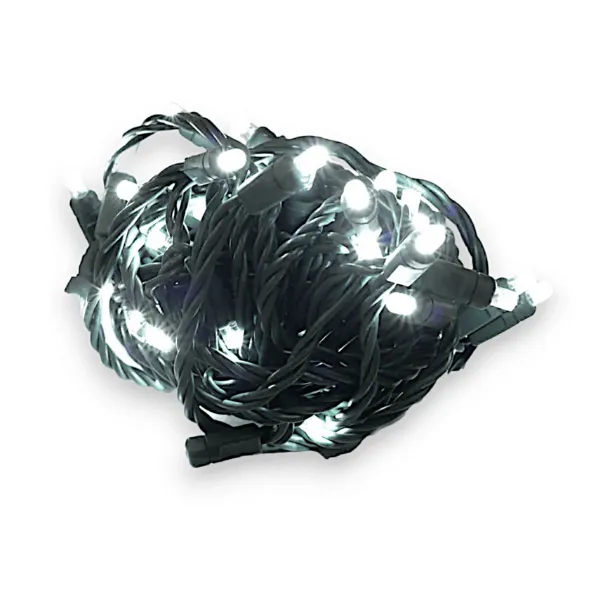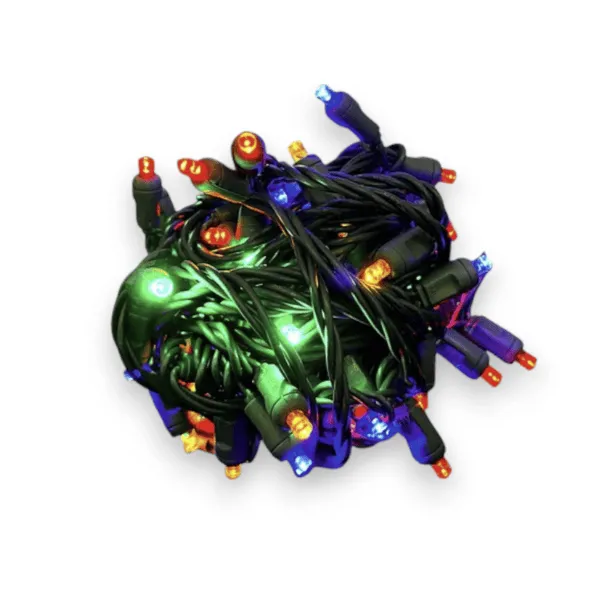Wholesale Pricing Presale Christmas Lights Minis
Pre-Season 50L 6" Spacing 5mm LED Mini Lights (Concave) 24/Case
AS LOW AS $6.95 Per STRAND!
Transform your holiday displays with the ultimate lighting solution: our 50 Count 5mm Wide LED Lights. Designed with professional installers and large-scale projects in mind, these lights offer unmatched performance and reliability. Whether you're wrapping trees, accentuating architectural features, or illuminating expansive commercial spaces, these lights deliver vibrant, uniform brilliance with every string. Built to last, energy-efficient, and easy to set up, they are the go-to choice for anyone looking to create stunning, worry-free displays this season. From their patented one-piece construction to their pre-balled convenience, these LED mini lights are engineered to save you time, money, and effort while dazzling your clients and guests.
Key Features:
50 Count 5mm Wide LED Lights: Each string features 50 high-quality LED bulbs spaced 6 inches apart on a 25-foot green wire. These lights are ideal for wrapping trees, bushes, and architectural features, providing a uniform and vibrant display that enhances any project.
High Connectivity for Large Installations: Connect up to 45 strings safely, allowing you to tackle large-scale installations with ease. This makes them perfect for professional installers managing multiple projects or expansive commercial properties.
Long-Lasting Performance: With a lifespan of up to 50,000 hours, these LED lights are built to withstand the rigors of professional use, ensuring they remain bright and reliable throughout the holiday season and beyond.
Patented One-Piece Construction: The innovative design prevents moisture-related corrosion, offering longer-lasting performance in all weather conditions. This durability is essential for outdoor installations where reliability is a must.
Energy Efficiency for Cost Savings: These LED mini lights consume up to 90% less energy than traditional incandescent bulbs, allowing you to reduce operational costs while maintaining a stunning display. This efficiency is especially important for large installations where energy consumption can quickly add up.
Virtually Unbreakable: The bulbs are engineered to be virtually unbreakable, with colors that won’t fade, chip, or crack. This durability means fewer replacements and more time to focus on new projects.
Pre-Balled for Efficient Setup: Time is money in professional installations, and these pre-balled lights ensure quick and easy setup, allowing you to complete projects faster and move on to the next job.
Meets UL 588 Safety Standards: Compliance with UL 588 safety standards ensures these lights are safe for both indoor and outdoor use, giving you peace of mind as you install them in various environments.
Illuminate your holiday displays with 50-count 5mm wide Minleon LED lights, spaced 6 inches apart on a durable 25-foot green wire. Designed for professional-grade performance, these lights allow you to safely connect up to 45 strings, making them perfect for large-scale installations. With a lifespan of up to 50,000 hours and energy-efficient LEDs that use 90% less energy than traditional bulbs, these lights offer long-lasting brilliance while saving on costs. Virtually unbreakable and pre-balled for hassle-free setup, they meet all UL safety standards and perfectly match the color temperature of Minleon C7 and C9 bulbs for a seamless, polished display.
Key Features:
50-count 5mm wide Minleon LED lights, spaced 6″ apart on green wire, with a total length of 25ft.
Safely connect up to 45 strings, making large displays easy to create.
Lifespan up to 50,000 hours, ensuring your lights last season after season.
Energy-efficient LEDs, using up to 90% less energy than traditional lights.
Virtually unbreakable bulbs that won’t fade, chip, or crack over time.
Pre-balled for easy Installation, so you can set up quickly and hassle-free.
Meets all UL safety standards, ensuring your display is safe and reliable.
All White temperature match to the C7&C9 Minleon Bulbs
Pre-Season 70L 4" Spacing Concave LED Mini Lights - 24/Case
As Low as $7.92 per Strand
Create dazzling, high-impact displays with 70 Count 5mm Wide LED Lights. Featuring 70 LED bulbs spaced just 4 inches apart on a 23.5-foot green wire, these lights deliver a denser, brighter, and more vibrant illumination that grabs attention. Safely connect up to 45 strings for expansive installations, while their energy-efficient design reduces power usage by up to 90%. Built for durability, these lights feature patented one-piece construction to prevent moisture-related issues and virtually unbreakable bulbs that maintain their vivid color. With a lifespan of up to 50,000 hours, pre-balled convenience for quick setup, and compliance with UL 588 safety standards, these lights are the ultimate choice for reliable, professional-grade installations indoors or outdoors.
Key Features:
70 Count 5mm Wide LED Lights: With 70 LED bulbs spaced 4 inches apart on a 23.5-foot green wire, these lights offer a more concentrated and impactful look compared to 50L sets. The smaller spacing results in a denser display of lights, drawing more attention with brighter, more intense illumination.
High Connectivity: Safely connect up to 45 strings, making these lights ideal for extensive installations that require consistent, reliable lighting across large areas.
Long Lifespan: Enjoy up to 50,000 hours of bright, consistent light. These bulbs are built to last, reducing the need for frequent replacements and maintenance.
Patented One-Piece Construction: This design eliminates the risk of moisture-related corrosion, ensuring longer-lasting lights even in challenging outdoor environments.
Energy Efficient: LED technology allows these lights to use up to 90% less energy than traditional incandescent bulbs, lowering energy costs and enabling longer runs without overloading circuits.
Virtually Unbreakable Bulbs: The durable construction of these bulbs ensures they are virtually unbreakable, with colors that won’t fade, chip, or crack, keeping your displays vibrant year after year.
Pre-Balled for Quick Setup: These lights come pre-balled, making installation quick and easy, allowing you to complete projects faster and with less effort.
Meets UL 588 Safety Standards: These lights are certified for both indoor and outdoor use, meeting all safety standards and providing peace of mind during installation.
Pre-Season Minleon 70L Mini Lights - 24/Case
AS LOW AS $9.37 Per STRAND!
Light up your displays with 70-count Minleon LED lights, spaced 4 inches apart on a durable green wire for a concentrated, eye-catching look. These energy-efficient LEDs use 90% less power than traditional lights and have a remarkable lifespan of up to 50,000 hours, ensuring they shine season after season. Safely connect up to 45 strings for effortless large-scale installations, while virtually unbreakable bulbs maintain their vibrant colors without fading, chipping, or cracking. Pre-balled for quick and easy setup, these lights meet all UL safety standards, making them a reliable, hassle-free choice for indoor and outdoor use.
Key Features:
These bulbs are made of durable, multi-faceted plastic so they won't fade, chip, or break like incandescent bulbs
Reduce your power consumption by more than 90% compared with conventional incandescent bulbs)
0.58W and 0.66W actual power consumption, but use 2W for installation calculation purposes
Fits into any standard C7 socket; E12 base
Frequently Asked Questions
Can I use these lights outdoors?
Yes, these lights are built for both indoor and outdoor use. They meet UL 588 safety standards, ensuring they are safe and reliable in all environments.
What is the lifespan of the Minleon LED mini lights?
The Minleon LED mini lights have an impressive lifespan of up to 50,000 hours, ensuring they remain bright and reliable for multiple holiday seasons.
How many strings of lights can I safely connect together?
You can safely connect up to 45 strings of Minleon LED mini lights, making them perfect for large-scale installations or extensive holiday displays.
Are these lights energy-efficient?
Absolutely! The LED technology in these lights uses up to 90% less energy than traditional incandescent bulbs, helping you save on energy costs while still delivering a brilliant display.
What makes these lights more durable than others?
The Minleon LED mini lights are designed with virtually unbreakable bulbs that are resistant to fading, chipping, or cracking, and they feature a patented one-piece construction that prevents moisture-related corrosion for longer-lasting performance.
How easy is it to install these lights?
These lights come pre-balled, making the setup process quick and hassle-free, so you can complete your installations faster and move on to the next job with ease.
What is the difference between concave vs convex
Concave Christmas lights feature a flat or slightly rounded top with a wider, bowl-shaped base. This design distributes light evenly in all directions, creating a bright, uniform glow visible from any angle. Professionals often choose concave lights for projects like wrapping trees because the even light distribution creates a sparkling effect as you move around the tree, adding depth and vibrancy to the display. In contrast, convex Christmas lights have a rounded or dome-shaped bulb that focuses light outward in a more directional manner. This creates a brighter, more concentrated point of light, making them ideal for installations requiring precise lighting placement, such as highlighting architectural features. Both designs offer unique benefits depending on the desired effect and application.
Discover Expert Tips on Our Blog

$1 MILLION Installing Christmas Lights (His Commercial Secrets Revealed)
Understanding the Commercial Christmas Lights Market
The commercial Christmas lights industry represents a significant opportunity for installers looking to scale their businesses beyond residential work. While many installers focus exclusively on homeowners, the commercial sector offers larger contracts, more predictable revenue streams, and the potential for multi-year agreements that can transform a seasonal side hustle into a thriving year-round enterprise.
Commercial work encompasses everything from small HOA entrance displays to massive shopping center installations. The key difference isn't just the scale—it's the professional approach required to succeed in this space. Property management companies, municipalities, and corporate clients expect a level of professionalism, documentation, and reliability that goes beyond what residential customers typically demand.
The Journey from Residential to Commercial
Many successful commercial installers start with residential work, building their skills, equipment inventory, and business systems before transitioning into larger projects. This progression allows you to develop the operational foundation necessary for handling complex commercial installations while generating cash flow from smaller jobs.
The transition often begins with a single commercial opportunity—perhaps a $20,000 contract spread over several years. While this might seem modest compared to some residential neighborhoods, the key advantage lies in the projected revenue and professional relationships you build. A six-year contract at $20,000 annually represents $120,000 in guaranteed revenue, provided you maintain the quality and service levels expected.
Essential Requirements for Commercial Work
Insurance and Documentation
Before approaching any commercial client, you need proper insurance coverage and documentation. Most property management companies require:
General liability insurance (typically $1-3 million)
Commercial auto insurance
Workers' compensation coverage
A current Certificate of Insurance (COI)
W-9 form with your EIN (Employer Identification Number)
Some larger clients may require excess liability policies or higher coverage limits. It's crucial to understand these requirements before bidding, as inadequate insurance will immediately disqualify you from consideration.
Business Systems and Professionalism
Commercial clients expect professional business operations. This means:
Using a Customer Relationship Management (CRM) system
Providing detailed proposals and contracts
Maintaining accurate financial records
Having clear terms and conditions
Offering professional invoicing and payment processing
Without these systems in place, you'll struggle to compete with established commercial installers who can demonstrate their professionalism through every interaction.
Finding and Securing Commercial Clients
Building Relationships with Property Managers
Property management companies control numerous commercial properties and can become valuable long-term partners. To connect with them:
Research local property management companies
Call and ask about their vendor requirements
Request information about becoming an approved vendor
Understand their credentialing process (which can take 45+ days)
Follow up consistently and professionally
Property managers want reliable vendors who make their jobs easier. They're managing multiple properties with various maintenance needs, and Christmas lights are just one component. Position yourself as a solution provider who can handle everything related to holiday lighting without creating additional work for them.
Understanding RFPs and Municipal Contracts
Municipalities and large corporations often use Request for Proposals (RFPs) to select Christmas lighting vendors. Learning to navigate this process opens doors to substantial contracts. Key points include:
Monitor city and county websites for RFP announcements
Understand the specific requirements and submission deadlines
Provide detailed responses addressing every requirement
Include proof of insurance, references, and portfolio examples
Be prepared for longer decision-making timelines
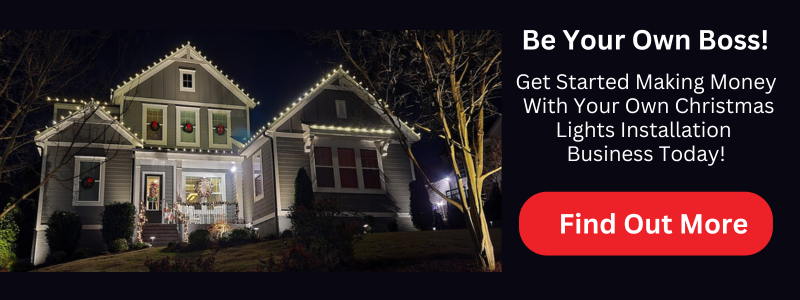
Pricing and Profitability in Commercial Work
Understanding Profit Per Man Hour
One crucial metric for commercial work is profit per man hour—not just gross revenue. A $5,000 HOA entrance that takes one crew half a day to install may be more profitable than a $20,000 installation requiring a week of labor. Calculate your true profitability by considering:
Material costs
Labor expenses (including payroll taxes)
Equipment depreciation
Travel time and vehicle costs
Administrative overhead
Commercial work often provides better profit margins per man hour than residential, but only when properly priced and efficiently executed.
Avoiding Common Pricing Mistakes
Many installers underbid commercial work, either from inexperience or desperation to land contracts. This leads to:
Inadequate profit margins
Inability to scale operations
Poor service quality due to resource constraints
Eventual business failure
Review your pricing annually and ensure it reflects your true costs plus a healthy profit margin. Remember that commercial clients often value reliability and quality over the lowest price.
Managing Commercial Projects Successfully
Equipment and Inventory Considerations
Commercial installations require different equipment than residential work. Consider investing in:
Commercial-grade LED lighting
Heavy-duty extension cords and power distribution
Specialized installation equipment (lifts, tall ladders)
Storage solutions for off-season inventory
Custom elements like tower trees or oversized displays
Plan your equipment purchases strategically, as unutilized assets drain profitability. However, having the right tools enables you to take on lucrative projects that competitors can't handle.
Communication and Service Standards
Commercial clients expect prompt, professional communication. This includes:
Responding to maintenance calls within 24 hours
Providing regular project updates
Documenting all work with photos
Addressing concerns immediately
Maintaining consistent quality standards
Remember that many people see commercial displays—every burned-out bulb reflects on your company's reputation. Build maintenance into your pricing and service model.
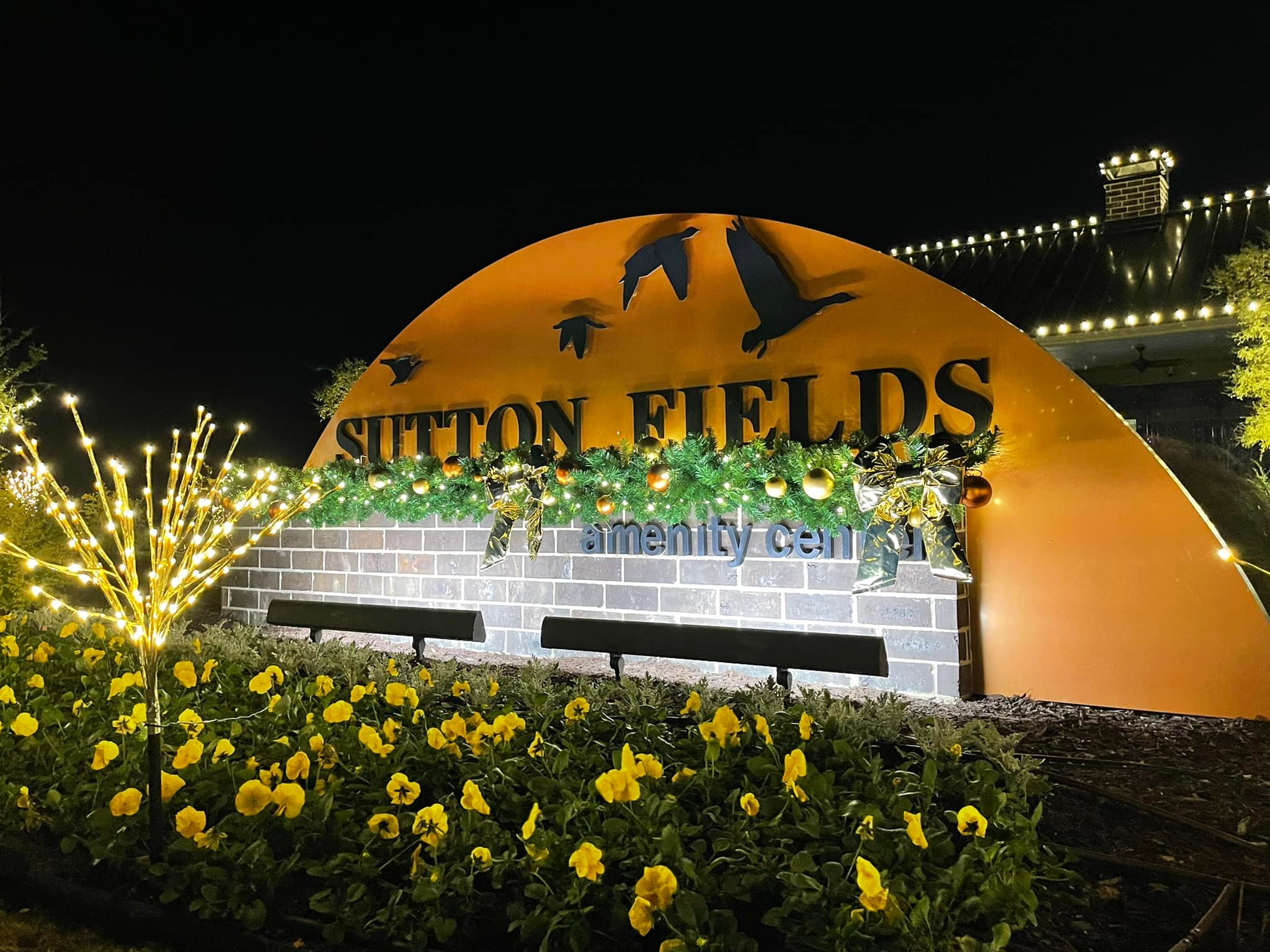
Scaling Your Commercial Operations
Building a Team
As you grow, you'll need reliable team members who can maintain your quality standards. Consider:
Hiring experienced installers during peak season
Training key employees for leadership roles
Creating standard operating procedures
Investing in safety training and equipment
Developing a company culture focused on excellence
Don't let fear of employees starting competing businesses prevent you from building a team. Focus on creating an environment where talented people want to stay and grow with your company.
Diversifying Your Commercial Portfolio
Avoid dependence on a single large client. Instead:
Target different market segments (retail, office, municipal)
Vary contract sizes and complexity
Build relationships with multiple property managers
Maintain a mix of commercial and high-end residential work
Plan for 10% annual client turnover
This diversification protects your business from the loss of any single contract while providing opportunities to upgrade to more profitable accounts.
Long-Term Success Strategies
Continuous Improvement
The commercial Christmas lighting industry evolves constantly. Stay competitive by:
Attending industry training and networking events
Learning from other successful installers
Investing in new technology and techniques
Refining your processes each season
Seeking feedback from clients and employees
Financial Management
Proper financial management becomes critical as you scale. Work with:
A qualified CPA familiar with seasonal businesses
Banking partners who understand your cash flow cycles
Insurance agents who can properly cover your risks
Legal counsel for contract review and protection
These professionals help you avoid costly mistakes and maximize profitability.
Building Your Reputation
In commercial work, reputation matters more than advertising. Focus on:
Delivering exceptional results on every project
Maintaining a professional portfolio and website
Collecting testimonials and case studies
Participating in industry associations
Building relationships throughout your market
Your reputation becomes your most valuable asset for securing new commercial contracts.
Transitioning from residential to commercial Christmas lighting installation requires dedication, professionalism, and strategic thinking. While the barriers to entry are higher than residential work, the rewards include larger contracts, predictable revenue, and the satisfaction of creating spectacular displays that thousands of people enjoy.
Success in commercial installation isn't about having the most equipment or the lowest prices—it's about understanding what commercial clients value and consistently delivering on those expectations. By focusing on professionalism, building strong relationships, and maintaining high standards, you can build a thriving commercial Christmas lighting business that provides year-round income and opportunities for growth.
The commercial market has room for installers who approach it professionally and strategically. Whether you're just starting to explore commercial opportunities or looking to expand your existing commercial operations, remember that success comes from treating this as a genuine business venture, not just a seasonal side hustle. Invest in the right insurance, systems, and relationships, and you'll find that commercial Christmas lighting can transform your business and your future.

What insurance coverage do I need for commercial Christmas lights installation?
Most commercial clients require general liability insurance between $1-3 million, commercial auto insurance, and workers' compensation coverage. Some larger clients may require excess liability policies. You'll need to provide a current Certificate of Insurance (COI) listing all coverage. Contact property management companies directly to understand their specific requirements, as they can vary significantly.
How long does it take to become an approved vendor for property management companies?
The vendor credentialing process typically takes 45 days or longer. This includes submitting your insurance documentation, W-9 form with EIN, business references, and completing their third-party verification process. Start this process well before the holiday season to ensure approval in time for bidding opportunities.
What's the difference between residential and commercial Christmas lights work?
Commercial work requires higher insurance limits, more extensive documentation, professional business systems, and different communication standards. While residential customers may accept informal quotes via text, commercial clients expect detailed proposals, contracts with clear terms, and professional invoicing. The scale is larger, but the profit per man hour is often better with multi-year contracts providing predictable revenue.
How do I calculate profit per man hour for commercial jobs?
Calculate profit per man hour by subtracting all costs (materials, labor including payroll taxes, equipment depreciation, vehicle expenses, and administrative overhead) from the job revenue, then divide by total man hours worked. A $5,000 job taking 4 hours may be more profitable than a $20,000 job requiring 80 hours of labor.
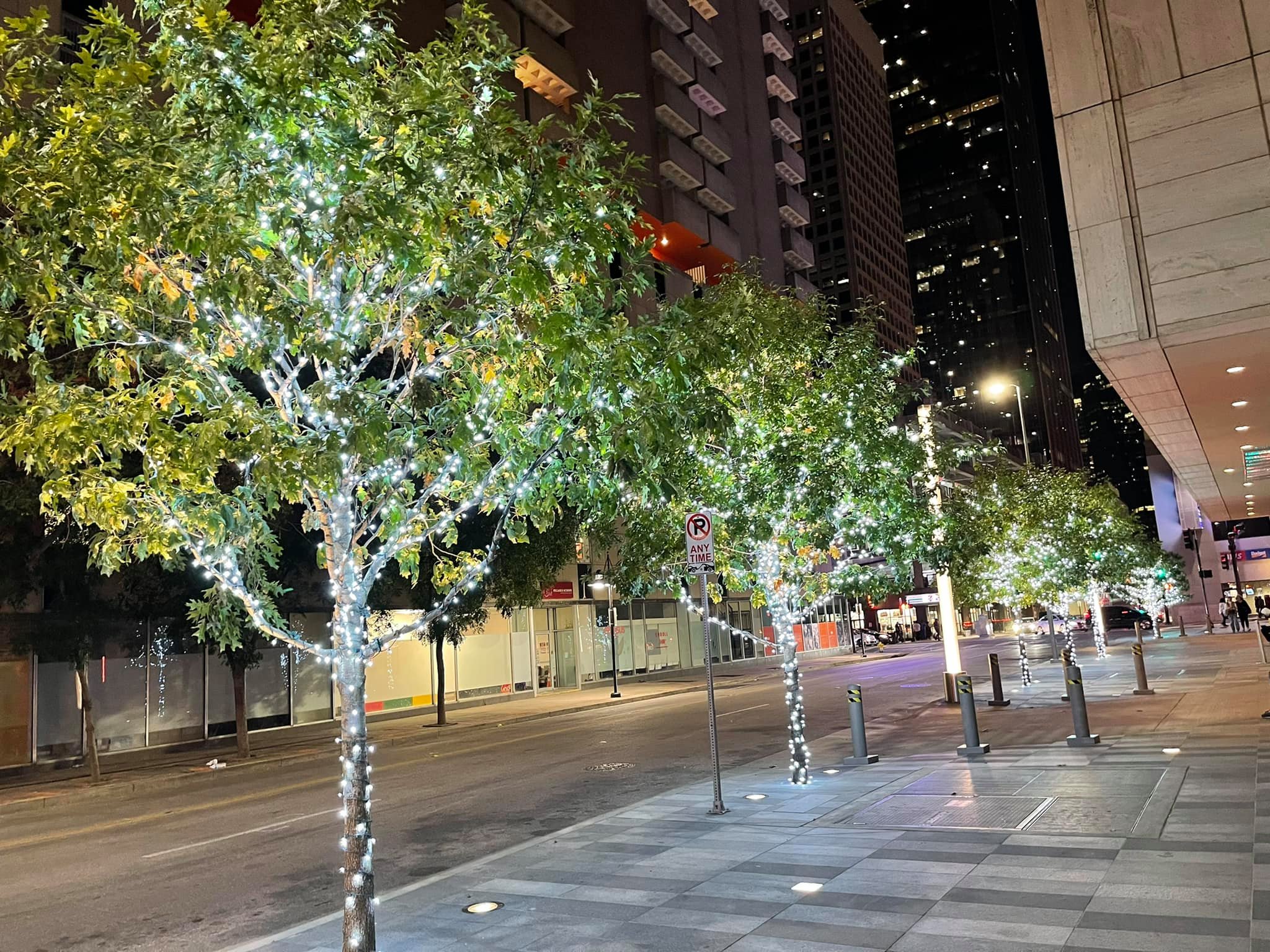
What equipment do I need for commercial installations?
Commercial installations require commercial-grade LED lighting, heavy-duty extension cords, specialized installation equipment like lifts and tall ladders, and storage solutions for off-season inventory. You may also need custom elements like tower trees. Plan equipment purchases strategically—unutilized assets drain profitability, but having the right tools enables you to bid on lucrative projects.
How do I find commercial Christmas lighting opportunities?
Start by researching local property management companies and calling to inquire about vendor requirements. Monitor city and county websites for RFPs (Request for Proposals). Build relationships by asking to become a trusted vendor and understanding their needs. Network with other contractors and join industry associations. Focus on building relationships rather than mass email campaigns.
Should I use a CRM system for commercial work?
Yes, a CRM system is essential for commercial work. It helps track multiple contracts, maintenance schedules, client communications, and financial data. Commercial clients expect professional operations, and a CRM demonstrates your ability to manage complex projects. It also provides historical data crucial for accurate bidding and helps ensure nothing falls through the cracks.
How much should I expect in annual client turnover?
Plan for approximately 10% annual client turnover in your commercial portfolio. This is normal and can actually benefit your business by allowing you to replace lower-margin contracts with more profitable ones. Diversify your client base to protect against the loss of any single large contract, and continuously prospect for new opportunities.
What's the biggest pricing mistake in commercial Christmas lighting?
The biggest mistake is underbidding to win contracts without fully understanding your true costs. This includes not accounting for maintenance calls, administrative time, equipment depreciation, and proper profit margins. Many installers focus only on material markup without considering profit per man hour, leading to busy but unprofitable operations that can't scale.
When should I transition from residential to commercial work?
Consider commercial work when you have established business systems, proper insurance, some equipment inventory, and experience managing installations. Many successful commercial installers start with one small commercial contract while maintaining residential work. You don't need to abandon residential entirely—high-end residential can be very profitable and provides good diversification alongside commercial contracts.
Copyright ©2025 All Right Reserved website designed by christmaslights.io
Terms of Service / Privacy Policy
Have questions or need assistance?
Contact us at (855)619-LITE


